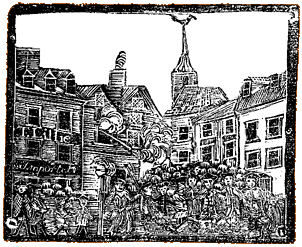 Christopher Seider was the young boy killed by Customs employee Ebenezer Richardson after a political demonstration turned violent on 22 Feb 1770, eleven days before the Boston Massacre. Back in this posting, I described what recent research has found about Christopher’s family. This post assembles the evidence about the boy's life in Boston.
Christopher Seider was the young boy killed by Customs employee Ebenezer Richardson after a political demonstration turned violent on 22 Feb 1770, eleven days before the Boston Massacre. Back in this posting, I described what recent research has found about Christopher’s family. This post assembles the evidence about the boy's life in Boston.In its 26 Feb 1770 report on the shooting, the Boston Evening-Post described Christopher as “a boy about eleven years of age, who lived with Madam Apthorp.” Grizzell Apthorp was a very wealthy widow who owned a mansion on Tremont Street. She was a stalwart of King’s Chapel, the upper-class Anglican church, where we can still see a marble memorial panel honoring her husband. Ordinary widows were called “Widow [Surname]”; rich widows got the “Madam” honorific.
Christopher’s parents didn’t live with Madam Apthorp, however. They lived, according to the same newspaper article, “in Frog Lane, opposite to Liberty Tree.” That street is now called Boylston, and it borders the Common on the south, leading to the Public Garden.
What was Christopher doing in the Apthorp house? Probably working. Bostonians of the late 1700s wouldn’t have called him a “servant,” though. They reserved that term for enslaved workers, whom the tax rolls labeled “servants for life.” All sources agree that the Seider family was poor, so "living with Madam Apthorp" probably meant his parents had sent him there to earn his keep.
Even with his job, it seems likely that Christopher was also getting lessons of some sort. On 13 Apr 1772, Samuel Adams wrote to James Warren of Plymouth about how he would look after a young servant:
I am much obligd for your Care in procurng for me a Boy. I shall be ready to receive him about the middle of next month and shall take the best care of him that shall be in my Power till he is 14 years old, perfecting him in his reading and teaching him to write and cypher if capable of it under my own Tuition for I cannot spare him the time to attend School. Will strictly regard his Morals and at the End of time I will if his parents shall desire it, seek a good place for him to learn such a Trade as he and they shall chuse.
There’s some evidence that, unlike Adams's servant, Christopher Seider did “attend School.” In the 1840s a woman named “Mrs. Preston” told a writer working on a (never finished) biography of Henry Knox that she’d gone to school with the German boy who was killed. If this is reliable, the school must have been private; girls didn’t yet attend Boston’s public schools. Christopher and the future Mrs. Preston might have learned to read together before they were seven, or they might have attended private writing lessons later.
Furthermore, the Boston News-Letter reported on 1 March 1770 that Christopher “was going from School” when he came across the political demonstration. That newspaper had been criticized for having “partially related” the story of his shooting the week before, and therefore in this issue may have tried to present Christopher's actions in the best light. On the other hand, Boston schools did let out early on Thursday mornings, and schoolboys did spontaneously join in protests.
It’s quite clear that Christopher Seider was a reader. The Evening-Post reported after his death that
several heroic pieces found in his pocket, particularly Wolfe’s Summit of human glory, give reason to think he had a martial genius and would have made a clever man.I haven’t found any broadside titled “Wolfe’s Summit of human glory,” but this passage implies it was a martial poem about Gen. James Wolfe and the Battle of Quebec. And that was only one of “several heroic pieces” Christopher was carrying around with him when he died.
Actually, Charles Street -- not Boylston -- divides the Boston Common from the Public Garden (no "s" at the end).
ReplyDeleteQuite right. Frog Lane/Boylston Street defines one edge of the Common and then connects with Charles Street, which continues the boundary. I’ll correct that.
ReplyDelete